With the investment in billions of IoT devices and the market share of trillions of dollars, this makes us have to undergo rigorous considerations in determining the structural design of edge node sensors or intelligent nodes to make the right choice. These tiny edge sensors not only provide important data but we also want to ensure it's safety while using the lowest power, cost and space. Some complex processing tasks of the edge nodes can be performed by the IoT gateway, which brings more than just security intelligence.
The main components of the IoT system include edge node sensors or modules, which are mainly used to collect sensor data. The IoT gateway is used to process data that fuses all sensors, and maintains communication connections with cloud servers or other edge nodes. The cloud server is used for non-real-time data. Analysis and storage, and finally the mobile app is used to render the results of these analyses.
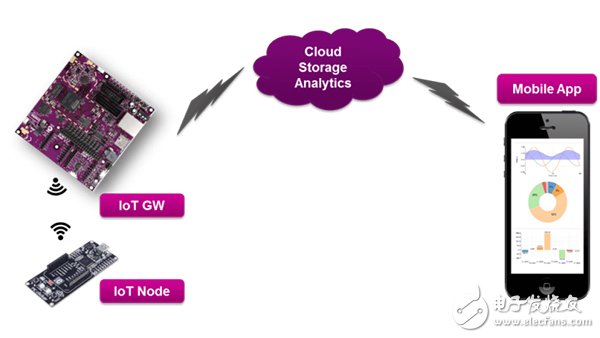
This article introduces how to implement each IoT node and IoT gateway based on MIPS CPUs and microcontrollers, and how architecture design for parallelization, security, and virtualization can improve system performance and security.
From the analysis of MIPS chips, parallelization, virtualization and security can be extended to multi-threading, hardware virtualization and OmniShield security technology. We will briefly understand these key technologies before diving into the IoT node/gateway design.
OnmiShield technology guarantees the security of next-generation SoCs. Unlike other solutions, we can set up secure and non-secure partitions in a simple binary way. Of course, OmniShield security technology not only creates multiple different security partitions, but also supports applications in each secure/non-secure zone or The operating system is capable of independent operation and complementary interference.
Hardware virtualization is a prerequisite for processor OmniShield technology, ensuring that secure zone applications are executed efficiently and reliably, and are absolutely isolated from other applications while also being protected from non-secure partitioned applications.
Finally, multi-threading technology helps optimize parallel and complex applications, making a single-core processor appear to be an SMP (Symmetric Multiprocessing) operating system, similar to two separate processor cores. Further, the two virtual processor cores are capable of supporting multiple operating systems or combinations of operating systems and "bare board" applications.
With these insights in mind, we can now learn more about how IoT nodes and IoT gateways are implemented, and how we apply these techniques.
Internet of Things (IoT) node unit
.
The Internet of Things (IoT) node can be broadly divided into the following three parts—smart sensors, intelligent sound processors, and intelligent high-performance processors.
Smart sensors are mainly used for sensors at the edge nodes. They are low in cost and low in power consumption. They can be operated for one year or longer with one AA battery or button battery. It typically includes only one microcontroller unit to enable all application functions while maintaining low power interconnect and edge data analysis. Of course, another important parameter for these billions of tiny sensors is safety.
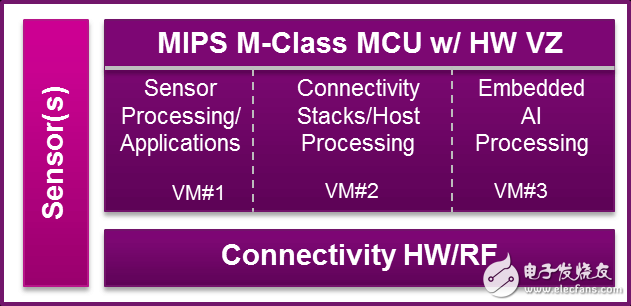
As shown in the figure above, the MIPS Microcontroller M Series features hardware virtualization to ensure isolated operation of the sensor application, interconnect protocol stack, and embedded AI processing. Supports a variety of popular interconnect technologies such as BLE, 802.15.4, 6LoWPAN, Thread, Zigbee, WiFi and cellular network technology NB-IoT, with 2 AA batteries to ensure 10 years of use, long battery life and low the cost of. In some application scenarios, network interconnection technologies such as WiFi and cellular technology IoT node modules can directly connect to the cloud server and send various messages and data. Of course, in other application scenarios, we can also implement the IoT gateway module. Scenes using edge sensors include smart home security and automation, car networking, tracking and logistics management, container cargo monitoring, consumer electronics such as smart refrigerators, smart washing machines, smart beverage machines, smart trays and smart utilities.
The intelligent sound processor is a more advanced sensor node that adds sound processing power to the edge nodes. This requires more computation, and a CPU must accommodate the integration of different numbers of sound collection microphones in addition to the additional computational requirements of sound calculations. Some functions are required to be implemented on the processor, such as sound triggers to wake up the processor to begin decoding sound commands, adaptive beamforming to support multiple sound microphones, echo cancellation and noise to avoid false identification or detection.
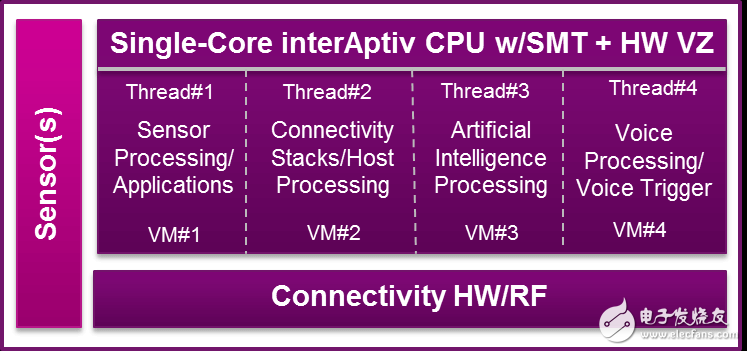
All of these features, such as voice data processing, interconnect processing, artificial intelligence algorithms, and sensor applications, can be implemented and optimized on the MIPS interApTIv family of multi-threaded processors. There are already many popular sound triggers and services such as Amazon's Alexa, Google's OK Google, Apple's Siri and Microsoft's Cortana. Alexa Sound Services is now integrated into a wide range of consumer electronics products you can think of, from refrigerators to TVs, cars, and smart microphones and smartphones.
Almost all of these devices support WiFi or cellular network connectivity to enable interoperability with voice services in the cloud.
Intelligent high-performance processors are ideal for processing intensive applications such as smart interconnect cameras. The high-performance processor not only integrates all the features of an intelligent sound processor but also integrates a video accelerator, a dedicated analysis engine, and ISP camera support. For more performance requirements and the functions that edge processors need to implement, our system may consist of more than one high-performance processor core or two or four. The MIPS 64-bit I6400 processor is ideal for this type of application.
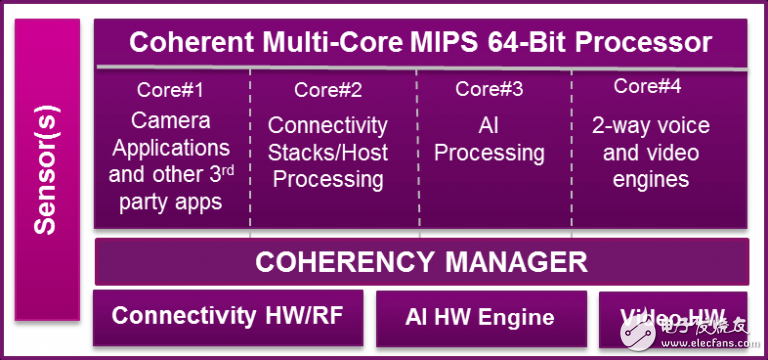
Internet of Things (IoT) Gateway
When the edge nodes of our system are only used to output the data collected by the sensor nodes or put some data processing tasks into the Internet of Things (IoT) gateway to execute the situation or scenario, then the Internet of Things (IoT) gateway is implemented with the cloud server or external System data communication should be the most scientific way. This solution further reduces the cost, system footprint and power requirements of edge nodes, and of course brings some optimizations to edge nodes, such as the introduction of intelligent algorithms, real-time data analysis, data fusion and higher security features. However, this increased performance and ease of use also increases the complexity of the implementation of the Internet of Things (IoT) gateway system. Because each sensor node may use different interconnect communication protocols, security protocols, and send packets of different formats and sizes, all of which require classification and refinement at the Internet of Things (IoT) gateway. Dealing with so many different situations is not an easy task. As shown in the above figure, the MIPS processor features multi-threading and hardware virtualization, supports multiple interconnect technologies and the Internet of Things (IoT) protocol, and can handle this complex architecture design efficiently and securely.
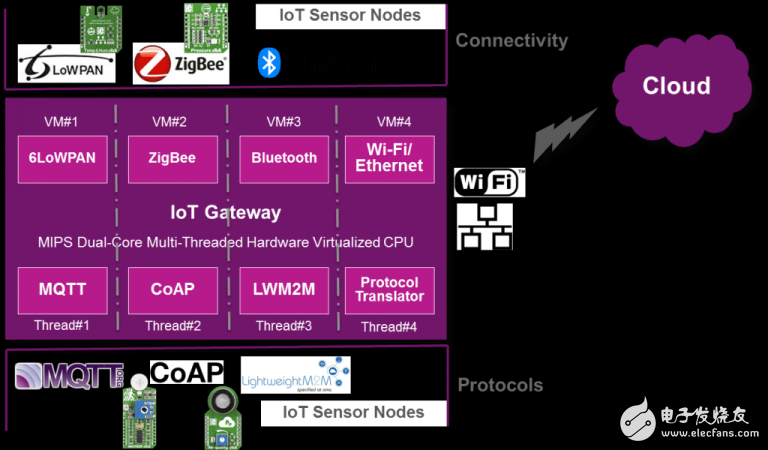
to sum up
Now let us summarize that all the types of processors mentioned above integrate the following modules - processing unit / microcontroller unit, interconnect module, intelligent algorithm of a certain function (deployed on the edge node device or placed in the cloud) Servers, sensors and functions required for specific applications such as sound and video capture processing. Edge devices can choose to connect directly to a cloud server or to an Internet of Things (IoT) gateway. The MIPS family of processors not only meets the functional requirements of different applications but also meets the requirements of Internet of Things (IoT) applications such as security, low power consumption and low cost.
A Small Computer System Interface (SCSI) connector, also pounced as [scuzzy" connector, is used for physically connecting and transferring data between computers and peripheral devices.
SCSI is the small computer system interface, which is an independent processor standard used for the system level interface between computer and intelligent devices (hard disk, floppy, optical drive, printer, scanner, etc.). It is an intelligent universal interface standard, which has the function of communicating with various types of peripherals. SCSI uses the standard software interface of ASPI (SCSI programming interface) to make the driver communicate with the SCSI adapter installed inside the computer. SCSI interface is widely used in high-speed data transmission technology on minicomputers. SCSI interface has many advantages, such as wide application range, multitask, wide bandwidth, low CPU utilization, and hot plug.
SCSI connectors type and interfaces
Centronics 50-pin connector: The Centronics 50-pin connector was once the most widely used SCSI connector. An external connector only, the Centronics is a SCSI-1 connector that looks the same as the Centronics cable that attaches to a parallel port printer. The Centronics 50-pin cable comes in male and female styles, and gender changers and cable converters are commonly available. Although used on older SCSI devices and external drive enclosures, this interface is no longer heavily used, due to its slow speed and short cable lengths.
High-density 50-pin connector: The high-density 50-pin connector is used on scanners and Jaz drives. It is one of the more common SCSI connectors and is usually used to connect SCSI-2 devices. Both ends of the cable are usually 50-pin male, while the sockets on the host adapter and external devices are 50-pin female.
DB 25-pin connector: The DB 25-pin or D Sub 25 is by far the most widely used connector. This connector is used for parallel and serial printers in addition to the many other devices available. Both ends of the cable are usually 25-pin male, while the sockets on the host adapter and external devices are 25-pin female. This cable is almost always an external connector.
Note: DB-25 SCSI CABLES are not compatible with and should not be used as serial or printer cables; serial cables and printer cables should not be used or attached to DB-25 SCSI adapters. You can short out the SCSI host adapter or the motherboard by using the wrong cable. Marking cables is the best way to avoid this.
IDC50 connector: The IDC50 is the most common internal SCSI connector. It is very similar to the standard IDE internal ribbon cable. The IDC50 SCSI cable is considerably wider then an IDE ribbon cable; in fact, it is usually the widest standard internal cable in use. This is a standard SCSI-2 10MBps internal SCSI cable. Many low-end cables have only two or three connectors, allowing for one or two devices to be attached to the cable. Seven-device cables are available, though they are often expensive and require a large case, as the cables may be four or five feet long.
High-density 68-pin connector: The high-density 68-pin connector is the SCSI connector of choice for SCSI-3 host adapters and peripherals. There is an internal ribbon cable version that looks very similar to the IDC50 connector. Many low-end cables have only two or three connectors, allowing for one or two devices to be attached to the cable. Seven-device cables are available, though they are often very expensive and require a large case, as the cables may be three or more feet long. Both ends of the external cable are usually 68-pin male, while the sockets on the host adapter and external devices are 68-pin female.
SCA 80-pin Micro-Centronics connector: SCA stands for Single Connector Attachment, a type of disk drive connector that includes connection pins for the power cables as well as the data wires. A SCA connector uses an 80-pin plug and socket to connect peripherals. This connector combines power, data channel, and ID configuration for fast installation and removal. SCA connectors are typically found only on high-end SCSI hard disks. The SCA interface was designed to provide a standard connection for systems using drives that can be hot-swapped. SCA makes swapping SCSI hard drives much easier than with traditional SCSI cables, plugs, and sockets. An adapter enables SCA drives to fit into standard SCSI enclosures.
SCSI SFF 8482: Also called "4x internal" by some vendors. This is a connector with the same form factor as SATA with the addition of a "bump" to key it specifically for SAS. (SATA drives can be plugged into SAS controllers, but SAS drives will not function with a SATA controller; hence, the necessity for the key bump on the connector.) As the name says, it's meant to be used internally, i.e., inside the computer case.
SCSI SFF 8484: Also called "32-pin" or "MultiLane". This is a high density connector usually intended to plug into the motherboard, controller, or backplane itself. Cables with this connector on one end usually have four individual SFF 8482 connectors on the other.
Serial Attached SCSI SFF 8470: Also called "4x external" by some vendors. This is simply a version of the SFF 8484 that's meant to be used with external (i.e., not located within the case) drives.
Scsi Connector,Half Pitch Scsi Connectors,Scsi Lead Half Pitch Male,SCSI (SAS) Connectors,Female Scsi Connector,SCSI Connectors I/O Connectors,Manufacturers and Suppliers in China
ShenZhen Antenk Electronics Co,Ltd , https://www.antenkelec.com
